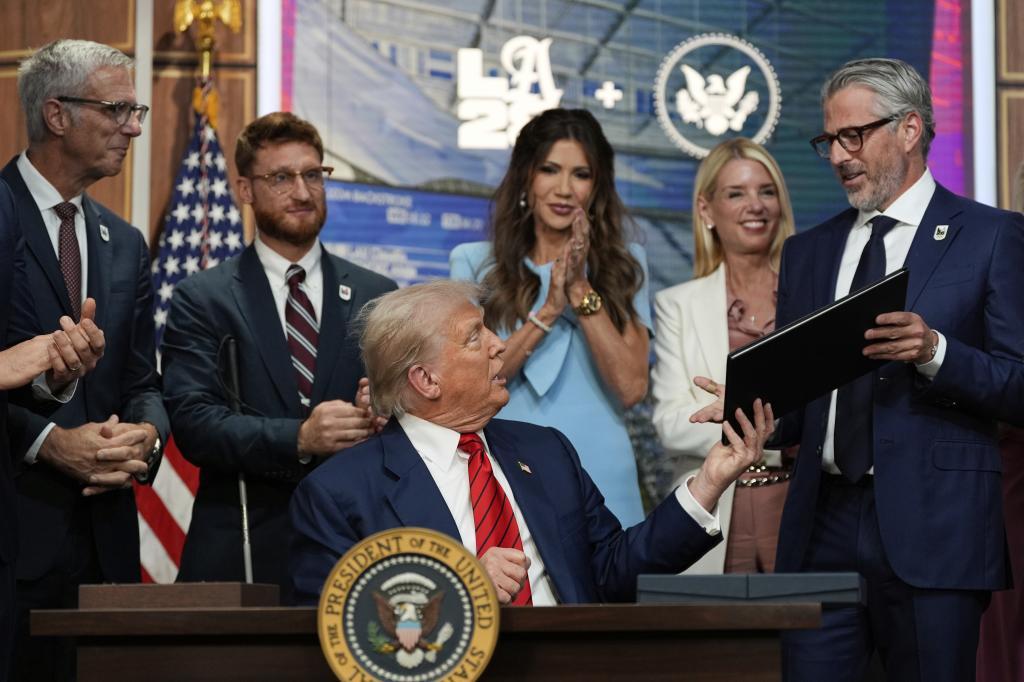Ten days after Donald Trump and the President of the European Commission, Ursula von der Leyen, reached a preliminary agreement for the former to increase tariffs on European goods by 15%, and less than 24 hours after the announcement by the European Commission that, as a result of that understanding, of the withdrawal of retaliatory tariffs that were going to be imposed on certain imports from the US, the US President has reopened the trade war. If the agreement of May 27 avoided tariffs of 25%, now the US threatens to raise them to 35%.
Basically, Trump wants the EU to give him and his government 600 billion dollars (around 520 billion euros) over the next three years. Otherwise, he says, he will impose a 35% tariff. He stated this in an interview with the financial television network CNBC yesterday. "They are going to give us 600 billion for us to invest in whatever we want. And that is a gift, not a loan," he said.
The idea of this fund is fundamentally based on the medieval vassalage concept where one political entity had to pay another more powerful one in exchange for protection, although given the limited interest of the US in NATO, it is unclear what protection Europe would receive. The absurdity is even greater when examined in detail because the EU, as such, does not have the capacity to invest in third countries. That is the competence of the member states and companies. These 520 billion are, if one is generous, an economic, political, and legal delusion of Donald Trump, or, if one wants to think negatively, an attempt to extort an ally.
The White House website on the trade agreement categorically states that "Europe will invest 600 billion dollars in the United States during President Trump's term, which will be added to the annual 100 billion already invested by European companies [in the US]", while the European Commission's website only states that "European companies have expressed interest in investing at least 600 billion dollars in various sectors [of the US] by 2029".
This is the same problem that Trump has created with Japan, with whom he reached an almost identical agreement five days before with the EU. In that case, the alleged donation from Tokyo, of 550 billion dollars (475 billion euros) will, according to the Secretary of Commerce and close confidant of the President, Howard Luttnick, be managed by Trump and, attention, 90% of its profits will go to the United States.
Additionally, there are two other issues that could explode next week, affecting microprocessors and pharmaceutical products, and possibly medical supplies. After much reluctance, the US agreed to include them in the May 27 agreement. However, there is a very important nuance difference between the EU and US versions. The EU states that "the 15% ceiling [on tariffs] will apply to any future tariffs on pharmaceuticals and semiconductors". The US version, however, makes no reference to future rates.
In his statements to CNBC, Trump, more than threatened, has promised tariffs on drugs "initially very small" but that within a year could reach 250%. This could be devastating for Ireland, a country where pharmaceutical exports to the US account for 9% of GDP.
For example, all the Botox in the world is manufactured in the Irish town of Westport, which has just 5,475 residents. The great paradox is that the company holding the copyright for that substance is American, Allergan, as are also Eli Lilly, Johnson & Johnson, or Pfizer, which are among the main exporters of pharmaceutical products from that island to the US. In fact, American pharmaceutical companies are behind much of the 'Irish miracle' or, if you prefer, the leprechaun economy, as humorously described by Nobel Prize-winning economist Paul Krugman. The only consolation is that the 250% tariffs only exist in Trump's mind.
The third point is the imposition of additional tariffs on the import of microprocessors, also known as 'chips'. This was expected, as the US launched an investigation in April into the trade of these electronic devices that are absolutely critical for the entire global economy, as they are not only in Artificial Intelligence models, quantum computers, but also in 'old economy' items such as cars (whose prices were affected by 'bottlenecks' in microprocessor manufacturing after Covid-19), household appliances, or, of course, video games (the world's most valuable company and global leader in microprocessors, the Californian Nvidia, achieved its primacy by developing memory chips for online games).
On July 27, an hour after Trump and Von der Leyen announced their agreement, Lutnick announced that the investigation into microprocessors "will conclude in two weeks". That means next Sunday. And the results of the investigation were already decided at the time it was launched. Countries trading with the US will be declared 'guilty', posing a "risk to the national security" of the United States. Trump will then have 90 days to impose tariffs, with the ensuing show of threats, last-minute meetings, and possibly insults on the social network, Trump Truth Social.
The 'chips' offensive impacts Asia more than Europe and, especially, the world's second most at-risk country after Palestine, Taiwan, which is the top exporter to the US. However, it could also have consequences in Europe, especially in Germany and, particularly, in The Netherlands. This is because the Dutch company ASML is the world leader in designing and manufacturing the machines used to manufacture microprocessors.
